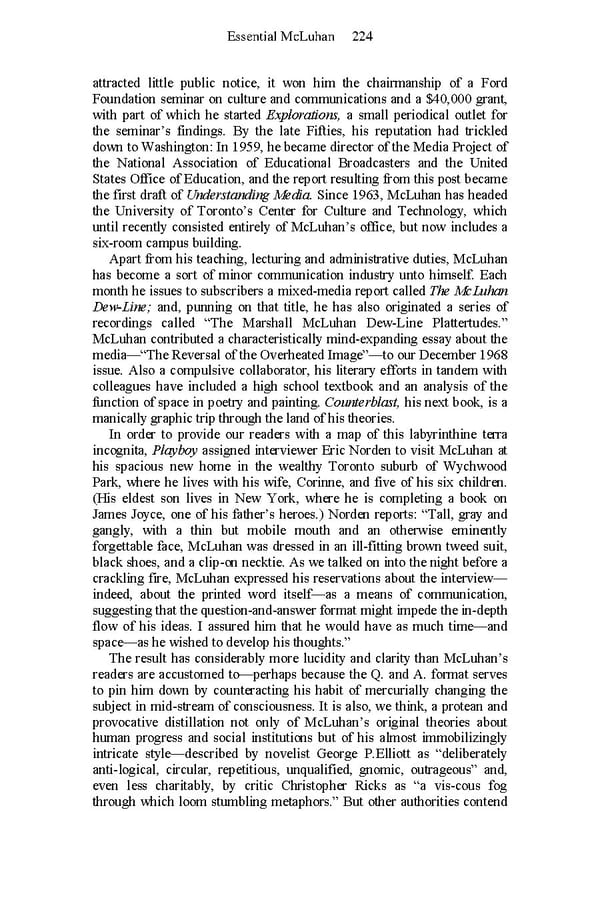Essential McLuhan 224 attracted little public notice, it won him the chairmanship of a Ford Foundation seminar on culture and communications and a $40,000 grant, with part of which he started Explorations, a small periodical outlet for the seminar’s findings. By the late Fifties, his reputation had trickled down to Washington: In 1959, he became director of the Media Project of the National Association of Educational Broadcasters and the United States Office of Education, and the report resulting from this post became the first draft of Understanding Media. Since 1963, McLuhan has headed the University of Toronto’s Center for Culture and Technology, which until recently consisted entirely of McLuhan’s office, but now includes a six-room campus building. Apart from his teaching, lecturing and administrative duties, McLuhan has become a sort of minor communication industry unto himself. Each month he issues to subscribers a mixed-media report called The McLuhan Dew-Line; and, punning on that title, he has also originated a series of recordings called “The Marshall McLuhan Dew-Line Plattertudes.” McLuhan contributed a characteristically mind-expanding essay about the media—“The Reversal of the Overheated Image”—to our December 1968 issue. Also a compulsive collaborator, his literary efforts in tandem with colleagues have included a high school textbook and an analysis of the function of space in poetry and painting. Counterblast, his next book, is a manically graphic trip through the land of his theories. In order to provide our readers with a map of this labyrinthine terra incognita, Playboy assigned interviewer Eric Norden to visit McLuhan at his spacious new home in the wealthy Toronto suburb of Wychwood Park, where he lives with his wife, Corinne, and five of his six children. (His eldest son lives in New York, where he is completing a book on James Joyce, one of his father’s heroes.) Norden reports: “Tall, gray and gangly, with a thin but mobile mouth and an otherwise eminently forgettable face, McLuhan was dressed in an ill-fitting brown tweed suit, black shoes, and a clip-on necktie. As we talked on into the night before a crackling fire, McLuhan expressed his reservations about the interview— indeed, about the printed word itself—as a means of communication, suggesting that the question-and-answer format might impede the in-depth flow of his ideas. I assured him that he would have as much time—and space—as he wished to develop his thoughts.” The result has considerably more lucidity and clarity than McLuhan’s readers are accustomed to—perhaps because the Q. and A. format serves to pin him down by counteracting his habit of mercurially changing the subject in mid-stream of consciousness. It is also, we think, a protean and provocative distillation not only of McLuhan’s original theories about human progress and social institutions but of his almost immobilizingly intricate style—described by novelist George P.Elliott as “deliberately anti-logical, circular, repetitious, unqualified, gnomic, outrageous” and, even less charitably, by critic Christopher Ricks as “a vis-cous fog through which loom stumbling metaphors.” But other authorities contend
 Essential McLuhan Page 230 Page 232
Essential McLuhan Page 230 Page 232